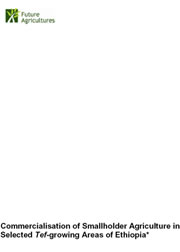{jathumbnail off} {jcomments off}The poverty-reduction strategy adopted by Ethiopia seeks to achieve growth through the commercialisation of smallholder agriculture. The Plan for Accelerated and Sustainable Development to End Poverty (PASDEP), Ethiopia.s strategic framework for 2005/06 – 2009/10, relies on a massive push to accelerate growth. This is to be achieved by efforts in two directions: commercialisation of agriculture, based on supporting the intensification of marketable farm products (both for domestic and export markets, and by both small and large farmers); and promoting much more rapid non-farm private sector growth (MoFED, 2005).
{jcomments off}The poverty-reduction strategy adopted by Ethiopia seeks to achieve growth through the commercialisation of smallholder agriculture. The Plan for Accelerated and Sustainable Development to End Poverty (PASDEP), Ethiopia.s strategic framework for 2005/06 – 2009/10, relies on a massive push to accelerate growth. This is to be achieved by efforts in two directions: commercialisation of agriculture, based on supporting the intensification of marketable farm products (both for domestic and export markets, and by both small and large farmers); and promoting much more rapid non-farm private sector growth (MoFED, 2005).
This study aims to contribute to this plan by identifying factors that can deepen and expand the scope of market participation of smallholders. Commercialisation of agriculture is also a core research theme of the Future Agricultures Consortium.
Future Agricultures. thematic work on agricultural commercialisation has observed that, in various countries, different modes of commercialisation co-exist and interact with each other (Leavy and Poulton 2007:17): hence the plural term, commercialisations. In Ethiopia, we suggest that the following existing categories of farmer could benefit from enhanced commercialisation (or “market-oriented agricultural growth”). These four categories represent four potentially complementary “pathways” for commercialisation policy.
1. Smallholder family farms
- (Type A) Farmers in remote, drought-prone or low-potential areas, generally regarded as “subsistence-oriented” but in fact interacting with markets both as buyers and as sellers. The policy challenge posed by these farmers is to improve their terms of engagement with markets, as well as raising productivity and diversifying livelihoods.
- (Type B) Small farmers who are already market-oriented, producing crops partly or
- wholly for sale alongside crops for their own consumption.
- Such farmers tend to be in locations with favourable growing and marketing conditions, and tend to focus on specific high-value commodities.
2. Small investor-farmers
- Individuals or small groups of partners, often educated and urban-based; sometimes agricultural professionals with a background in government or development agencies or former state farms; often investing in farming as a secondary activity. These farmers are referred to in World Bank terminology as “emerging commercial
- farmers”, suggesting an expected linear trajectory towards larger-scale agri-business. However, we suggest that they are in fact a separate category. In Ethiopia they have started to re-emerge only in the last few years, when access to land for such investments has been made possible.
3. Large-scale “agri–business”
- These are generally capital-intensive enterprises (though they also generate employment), and may be either private or state-owned. Examples are the large.
